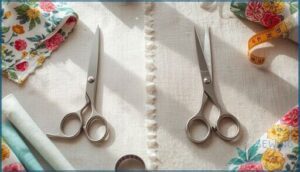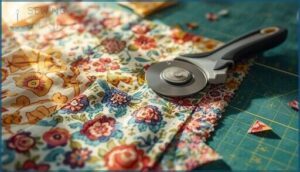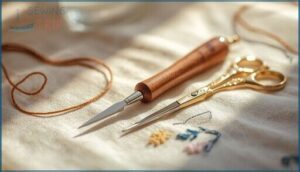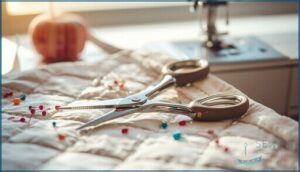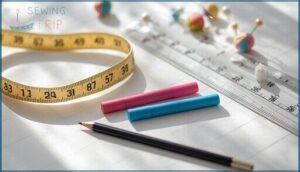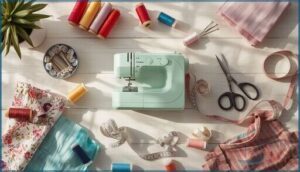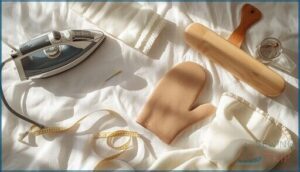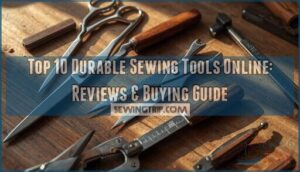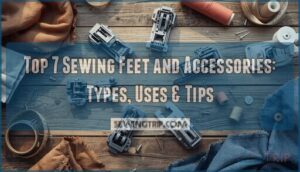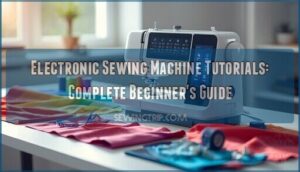This site is supported by our readers. We may earn a commission, at no cost to you, if you purchase through links.
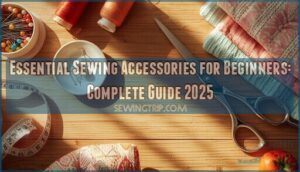 Most sewing baskets start out as a hopeful tangle—a tape measure hides beneath stray threads, scissors vanish right when you need them, and pins test your reflexes more than your patience. The landscape of sewing accessories for beginners can seem like a maze of mysterious gadgets, each promising to transform a pile of fabric into something you’d actually wear outside.
Most sewing baskets start out as a hopeful tangle—a tape measure hides beneath stray threads, scissors vanish right when you need them, and pins test your reflexes more than your patience. The landscape of sewing accessories for beginners can seem like a maze of mysterious gadgets, each promising to transform a pile of fabric into something you’d actually wear outside.
But here’s a secret: with a handful of thoughtfully chosen tools, your workspace can turn from chaotic to calm, and those first crooked stitches become stepping stones to projects you’re proud to show off. Let’s get you set up for sewing success.
Table Of Contents
Key Takeaways
- Choosing just a few quality, purpose-built tools—like fabric scissors, seam rippers, and measuring tapes—makes sewing smoother and less frustrating for beginners.
- Rotary cutters with cutting mats, along with clear rulers, help you cut fabric accurately and safely, giving your projects a professional edge from the start.
- Keeping your tools organized and well maintained, plus setting up a comfortable, well-lit sewing space, helps you stay focused and enjoy the process.
- Learning to match needle and thread to your fabric, and using pressing tools for crisp seams, turns small beginner steps into real sewing confidence.
Essential Sewing Tools for Beginners
Before you start your first project, you’ll need a handful of essential cutting tools to make the work easier and more accurate.
Each tool has a specific job, and knowing which one to reach for will save you time and frustration.
Let’s walk through the basics you’ll actually use.
Fabric Scissors Vs. Pinking Shears
When you’re just starting out, knowing which scissors to grab can feel like choosing between a fork and a spoon—they both cut, but each one’s built for a different job. Here’s the breakdown:
- Fabric scissors are your go-to for cutting accuracy on most fabric types—keep them sharp and use them only for sewing supplies
- Pinking shears create zigzag edge finishes that stop fraying on woven materials, perfect for project suitability when seam finishing isn’t planned
- Regular scissors dull quickly on fabric cutting, so invest in dedicated shears for clean, professional results
Rotary Cutters and Cutting Mats
If you’ve mastered scissors, you’re ready to meet their speedier cousin—the rotary cutter. It slices through multiple fabric layers like a pizza wheel, but only when paired with a self-healing cutting mat underneath. Choose blade types (45mm works for most projects), practice safety measures like closing the guard after each cut, and look for ergonomic grips to prevent hand fatigue during extended cutting sessions.
| Feature | Rotary Cutter | Cutting Mat | Why It Matters |
|---|---|---|---|
| Size Options | 28mm, 45mm, 60mm blade types | 12″×18″ to 24″×36″ mat composition | Match blade to project scale; larger mats suit long fabric cutting |
| Key Benefit | Precision cutting techniques for straight lines | Self-healing surface protects blades | Clean cuts without dulling your cutting tools |
| Safety Feature | Retractable guard (essential safety practices) | Non-slip backing | Prevents accidents and mat shifting during use |
Seam Rippers and Embroidery Scissors
Mistakes happen to everyone who sews, and that’s exactly why seam rippers earn their spot in your tool kit—they undo wonky stitches in seconds, while embroidery scissors are useful for the delicate snips that bigger shears can’t reach.
Look for seam ripper types with ergonomic grips and a sharp point for precise stitch removal techniques. Embroidery scissor care means keeping those fine tips sharp for specialty scissor uses like trimming thread tails close to fabric.
These sewing tools transform frustrating mistakes into quick fixes.
Must-Have Thread Snips
While embroidery scissors manage the tiny detail work, thread snips are the tool you’ll grab dozens of times each project for quick, one-handed thread cuts right at your machine. They’re faster than scissors or a seam ripper for trimming excess thread.
Look for snip types with comfortable grips and sharp blade material—stainless steel works great. Keep these portable options near your sewing supplies for easy access, and wipe them clean after each use (maintenance tips that prevent sticky buildup from thread).
Measuring and Marking Must-Haves
Getting your measurements right can make or break a sewing project, so having the proper tools from the start matters more than you might think.
To get your measurements right and keep everything on track, you’ll want a handful of reliable tools for measuring fabric, marking out cutting lines, and lining things up as you sew.
Let’s look at the measuring and marking essentials that’ll help you avoid those “oops, I cut it wrong” moments.
Measuring Tapes and Seam Gauges
A measuring tape might seem like just another strip of fabric with numbers on it, but in sewing, it’s actually your best friend for getting things to fit just right. You’ll use it constantly for body measurements and checking fabric lengths—just make sure yours shows both inches and metric conversions for tape accuracy.
A seam gauge is equally handy for those smaller, precise tasks like marking hems or checking seam allowances, making these measuring and marking tools truly essential sewing tools in your kit.
Rulers, Yardsticks, and Transparent Guides
Once you’ve got your measuring tape sorted, transparent rulers and yardsticks step in to help you cut straight lines and check your fabric’s grain with confidence. These measuring tools offer accuracy, which matters when you’re using rulers for the rotary cutter, and metric conversion markings make pattern work easier.
Here’s why these measuring and marking tools belong in your toolkit:
- Transparent rulers let you see fabric patterns underneath while measuring
- Yardsticks manage long fabric lengths without constantly repositioning
- Specialized rulers with angles help cut bias strips and check grainlines
Choose ruler material that won’t warp, and you’ll have reliable storage solutions for years.
Fabric Marking Pens and Chalk
After you’ve measured and marked your cutting lines, fabric marking pens and chalk become your secret weapon for transferring pattern details like darts, buttonholes, and pleats right onto your material.
Marking tool types range from water-soluble pens to air-fading markers and traditional marking chalk. Check fabric compatibility first—some inks stain delicate materials.
Ink removal methods vary by type, while fading timeframes depend on your workspace humidity. Keep chalk sharpness tips handy for precise lines when marking fabric.
Pins, Sewing Clips, and Pin Cushions
Think of pins and clips as the helping hands you wish you had when fabric starts sliding around—they hold everything exactly where it needs to be while you sew. Explore different pin types—glass-head, ball-point, or quilting pins—and clip alternatives for thick materials.
A pin cushion with magnetic options keeps essential sewing supplies tidy, while cushion filling affects how smoothly pins slide in.
Try DIY projects to personalize your workspace.
Sewing Essentials Every Beginner Needs
Once you’ve gathered your measuring tools, it’s time to stock up on the basics that actually bring your projects to life.
Thread, needles, fabric, and a reliable sewing machine form the foundation of every beginner’s toolkit. Let’s walk through each essential so you know exactly what to look for.
Choosing The Right Needles and Thread
Your needles and thread aren’t just supplies—they’re the handshake between your fabric and your finished project, and picking the wrong combo can turn a simple seam into a frustrating tangle.
Take a moment to match Needle Types and Thread Weight to your fabric. Keep color matching in mind, and explore Specialty Threads to add flair. Choose wisely for fewer headaches!
Basic Fabrics for Practice Projects
Picking the right practice fabric is like finding your dance partner—it matters! Cotton fabric is every beginner’s reliable choice, thanks to its smooth handling and easy fixes. Muslin usage is big for test runs—cheap, forgiving, and perfect for tracing patterns. And don’t overlook scrap fabrics or sturdy polyester options for beginner projects—the more you try, the faster you’ll learn. Using leftover materials also means you can create eco-chic crafts while honing your skills.
- Cotton is the top pick for most beginner sewing projects
- Muslin works great for testing patterns and stitching basics
- Scrap fabrics and polyester blends are budget-friendly for repetitive practice
Interfacing and Batting for Structure
Now that you’ve got your fabric sorted, let’s talk about those secret helpers—interfacing and batting—that give your projects the shape and support they need. Think of fusible interfacing as a gentle hand holding your fabric firm, while batting’s loft—thick or thin—adds cozy body, especially to quilts.
Here’s a quick look:
| Material | What It Does |
|---|---|
| Fusible interfacing | Stabilizes with heat |
| Sew-in interfacing | Adds structure by stitching |
| Knit interfacing | Stretches with your fabric |
| Low-loft batting | Slim, for light projects |
| High-loft batting | Fluffy, for warmth |
Selecting Your First Sewing Machine
Choosing a sewing machine is a bit like finding the right dance partner—some are gentle, some flashy, but you want one that’ll help you feel comfortable and confident as you stitch that first seam. To keep things simple, focus on:
- Easy-to-use machine features
- Your budget considerations
- Reliable brands with good maintenance tips for beginner projects and sewing essentials
Pressing and Finishing Tools Explained
Finishing touches make all the difference in sewing, and the right pressing tools are a game changer.
Let’s break down which essentials will help you get crisp seams and a polished look. Here’s what you’ll want to have close at hand next.
Irons and Ironing Boards
When you’re ready to turn wrinkled fabric into crisp, professional-looking pieces, few tools make as much difference as a good iron paired with a sturdy ironing board. Adjust iron temperature settings based on fabric type—think cotton versus polyester. Steam vs. dry is your call, but always use a board with a snug cover for best results.
| Ironing Essential | Key Benefit |
|---|---|
| Steam iron | Addresses tough wrinkles |
| Board with thick cover | Protects and smooths fabric |
| Specialty tools | Aid precise pressing |
Tailor’s Hams and Seam Rolls
If you’ve ever wondered how to smooth out those tricky curves and corners, tailor’s hams and seam rolls have your back—and your seams. A ham helps press curves in sleeves or busts, while seam rolls tackle long, narrow areas—think pant legs.
Both are beginner sewing essentials for mastering pressing curves. DIY options abound, depending on fabric choice and shape needs.
Liquid Fray Preventors for Edges
At some point in your sewing adventures, nothing feels more frustrating than watching a freshly cut edge start to fray before you’ve even finished the project. Liquid fray preventors step in as a budget-friendly lifesaver.
Consider fabric compatibility and application techniques—just dab along the edge, allow proper drying time, and enjoy longevity that rivals more expensive sewing supplies. Truly, beginner sewing essentials!
Proper Pressing Techniques for Beginners
Although ironing can look tricky from the sidelines, proper pressing is pure magic for neat seams and crisp shapes. Rely on these smart moves:
- Use the right Heat Settings to suit your fabric.
- Press immediately after each seam—never just at the end.
- Let your steam iron and a padded ironing board work for you.
- Always test on scraps to prevent scorched surprises.
To achieve a smooth finish, remember to press seams open.
Smart Shopping and Organizing Tips
Sewing supplies can pile up fast, but with a little planning, you’ll stay ahead of the clutter. A few smart choices now will save you time and stress later.
As you gather everything for your kit, keep these tips in mind.
Budgeting for Sewing Accessories
It’s easy to feel sticker shock seeing the price of sewing tools add up. Take a deep breath—Accessory Cost Factors like fabric scissors and irons hit your wallet most, but deals exist.
Try Thrift Store Finds, Bundle Discounts, or even Swapping Supplies with a friend. Use a Budget Worksheet Tool to plan your spending and build your beginner sewing kit wisely.
Starter Kits Vs. Individual Tools
Ever notice how a pre-packed sewing kit feels like a grab bag at a carnival? Kit Value is great for starting out, but as your Skill Progression grows, so does your wish for Tool Longevity and Customization Options.
Splitting your Budget Allocation between basic sewing supplies and select tools lets you personalize your sewing for beginners journey.
Setting Up a Beginner-Friendly Sewing Space
Think of your sewing space as your creative playground—where every tool has its own cozy corner and inspiration comes easier when you know right where to look.
- Prioritize ergonomic setup with a sturdy table and comfy chair.
- Invest in good lighting solutions to reduce strain.
- Reserve space for your ironing board, cutting mat, and storage ideas that fit your budget considerations.
Organizing and Maintaining Your Supplies
Once your sewing nook feels settled, keeping your tools sorted and in good shape is the secret sauce that turns simple projects into smooth-sailing fun. Need a quick glance at sanity-saving organizing ideas? Check out this table for ways to keep all your sewing supplies tidy and ready for action:
| Supply Inventory | Storage Solutions | Cleaning Tools |
|---|---|---|
| Label your stash | Clear bins or jars | Lint rollers |
| Track thread use | Hanging organizers | Brush & cloth |
| Periodic audits | Drawer dividers | Blade sharpeners |
| Update sewing kit | Wall-mounted racks | Oil for machines |
Frequently Asked Questions (FAQs)
How to safely store sharp sewing tools?
Curious minds wonder—are sharp sewing tools really as risky as they seem?
In truth, Needle Storage boxes, Scissor Sheaths, and Rotary Holsters are lifesavers for sewing safety, Child Safety, and Pet Protection around scissors and pins.
What accessories help with hand sewing projects?
Needle threaders and thimbles make hand sewing easier on your fingers and eyes, while beeswax thread keeps thread smooth.
Embroidery hoops, sharp sewing needles, and sturdy thread are true hand sewing essentials for neat, comfy hand stitches.
How do you care for delicate vintage fabrics?
Sometimes the softest fabric is the one that demands the toughest care.
Store delicate vintage fabrics flat, use gentle washing sparingly, and choose careful stain removal.
Mend by hand sewing with fine thread, and always press on an ironing board.
What are the best lighting options for sewing?
Good lighting is a must in your sewing space. Go for LED task lighting—bright, energy-saving, and adjustable. Place lights above and beside your workspace. Choose bulbs with a neutral color temperature.
Natural light is ideal during the day!
How to travel with sewing supplies securely?
Long before email, traveling with sewing supplies was an art.
For safe journeys today, follow TSA Guidelines, use compact Needle Storage, protect fabric from snags, secure your kit with zippers, and choose portable irons—or skip them!
Conclusion
Imagine this: you reach for your fabric scissors, every tool right where it belongs, and the project unfurls with unexpected smoothness. That quickening heartbeat? It’s not just nerves—it’s the thrill of turning small steps into genuine progress.
With these sewing accessories for beginners, the jumble of “what do I need?” becomes silent. Your basket now spells out confidence in stitches.
Go ahead and get started—something wonderful might be waiting for you at the end of your next seam.
- https://www.youtube.com/watch?v=oC7MiFWJ6KU
- https://www.longancraft.com/blogs/sewing-tips/sewing-supplies-for-beginners
- https://www.reddit.com/r/SewingForBeginners/comments/1hrn7cs/what_accessories_do_you_wish_you_had_starting_out/
- https://winslets.com/blogs/sewing-basics/100-sewing-tools-and-equipment-for-beginner-and-advanced-sewists
- https://www.360iresearch.com/library/intelligence/sewing-supplies

